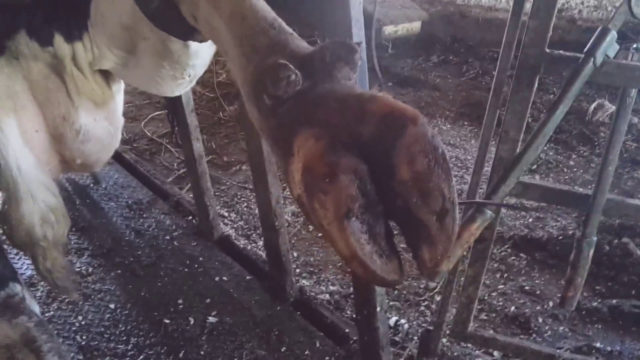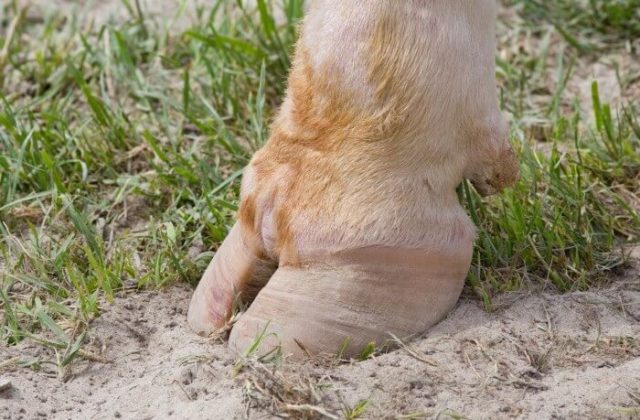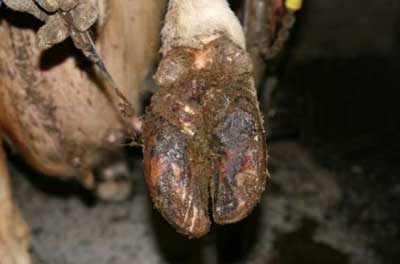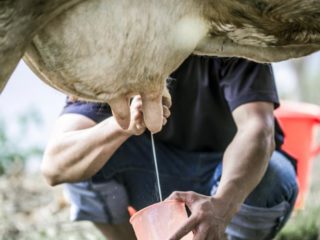Content
Corolla phlegmon in a cow is a purulent inflammation of the hoof corolla and the adjacent skin area. This disease occurs quite often in cattle, as a rule, it occurs as a result of an injury to the animal's hoof.
Causes of the disease
Often, after grazing in the pasture, the cow limps slightly. An inexperienced farmer may not pay attention to this, believing that the reason is a small scratch. But, it would seem, such a frivolous problem can lead to complications if the wound is not treated in a timely manner.
Corolla cellulitis is formed after infection. This also happens with significant damage: fracture, crack, prolonged compression of the nerve endings. Often during grazing, cows move through the mud, and in stalls they are sometimes in unsanitary conditions. This provokes the appearance of ulcers, cracks in the hooves.
If we add a weak immune system to these reasons, then phlegmon will appear as a complication after infection.
The causative agents of cellulitis in cows are staphylococci, streptococci, Escherichia coli. All of these microorganisms are found on the cow's hooves and are completely harmless until there is an entrance gate for infection - wounds or other injuries on the cow's limbs. Then the corolla becomes inflamed.
Sometimes phlegmon is caused by more complex and dangerous infections, for example, foot and mouth disease, pododermatitis.
Phlegmon flows in different ways. Sometimes the disease manifests itself as a small abscess. Timely autopsy and some therapeutic measures lead to a quick recovery. It happens that microorganisms penetrate deeply: into the subcutaneous tissue, into the base of the corolla skin, the border, then into the hairy area above the corolla, the interdigital gap. This development of the disease is considered very difficult, it is quite difficult.
Symptoms of corolla phlegmon
The disease is developing rapidly. As a rule, one of the first signs is the limping of the cow when moving, a swelling that appears on the corolla. When pressed, the cow moans and shudders.
Other signs of corolla phlegmon:
- the injured hoof is hot, the corneous tissue is exfoliated;
- an increase in the interdigital gap;
- lameness when moving;
- lack of appetite;
- increased body temperature;
- increased heart rate, shortness of breath;
- weak general condition of the animal;
- drop in milk yield;
- the cow lies more, when she tries to get up she staggers, she tries not to lean on the sore limb.
In the subcutaneous layer of the corolla, a green liquid is found. The swelling spreads to the walls of the hoof and toe. This area becomes painful and hard. If treatment is started immediately, the cow will be relieved in a week.
This is how the corolla phlegmon manifests itself in the initial stage of the disease - serous.
With the abscess stage, an abscess develops. If it is opened in a timely manner, then the animal recovers. If not, the infection affects the skin and interdigital cleft. A purulent-bloody exudate appears, and necrosis of all layers of the skin develops.
At the putrefactive stage of the disease, tissues die off and exfoliate, and ulcers form.
Depending on the area of the lesion, the phlegmon is divided into para-articular (develops in the toe part of the hoof) and perichondral (heel part).
Diagnosis of the disease
The survey begins with an examination of the cow's hooves. First, they determine the shape and see how much the hoof has grown. Then, injuries (wounds, ulcers, scratches) are found in the area of the corolla. When examining the joints, their mobility is checked. You should also check the temperature of the diseased organ by touching it with your hand. With an inflammatory process in the area of damage, it is increased.
More precisely, the disease can be determined by a blood test. As with any inflammatory process, the number of leukocytes in the blood rises. This indicates the formation of leukocyte neutrophilia. This is usually observed with the development of latent inflammation, the development of purulent processes. Such leukocytosis indicates an excessive focus of inflammation.
The final diagnosis is made after determining the cause of the development of the disease. If the reason for the development of corolla phlegmon is the occurrence of another disease, then the method of treatment will be non-standard. First, the doctor will have to treat the underlying disease.
In addition to the classical diagnosis of corolla phlegmon, arthropuncture of the hoof joint can be performed. The procedure involves drawing fluid from the affected area using a needle. The liquid is examined under laboratory conditions, after which an accurate diagnosis is made.
Treatment of corolla phlegmon in a cow
After confirming the disease, treatment should be prescribed immediately.
First of all, it is necessary to transfer the cow to a separate stall, isolate the calf from it. Lay clean straw for her, constantly changing it as needed.
On the affected area, you should carefully remove the hair, reduce the stratum corneum so that it does not press on the affected area. Next, you should treat the corolla area with iodine, chlorhexidine, and furacillin solution.
A compress with ichthyol or camphor alcohol can be applied to the site of inflammation to speed up the discharge of pus. The dressing is changed as it dries. The use of ichthyol ointment is also shown.
From injections, penicillin is prescribed intramuscularly to relieve inflammation and novocaine. Sometimes a circular blockade is performed, injecting this drug slightly above the affected area. This can be done every two days. You can inject into the area above the interdigital cleft.
To speed up the healing process, a calcium chloride solution and camphor serum are prescribed.
If the infection has become severe, surgery is performed, cutting the most dense areas with a scalpel, remove all dead cells. Next, apply a lotion with a solution of sodium chloride and treat with hydrogen peroxide. You can apply an antibiotic powder and apply a sterile dressing.
Forecast and prevention
The prognosis is favorable with quality and timely treatment.
Preventive measures should be directed to regular, daily inspection of the cow's hooves, especially after a walk. If injuries are found, immediately treat with any antiseptic. Pay attention to the maintenance of the cow - the pen should be clean, the bedding should be changed regularly. It is imperative to carry out timely cleaning and trimming of hooves.
It is important to revise the cow's diet and add vitamin supplements to the feed.
Conclusion
Corolla cellulitis in a cow is a complex, rapidly developing disease that can lead to adverse consequences. It can be avoided by treating the animal responsibly and treating all infectious diseases in a timely manner.











